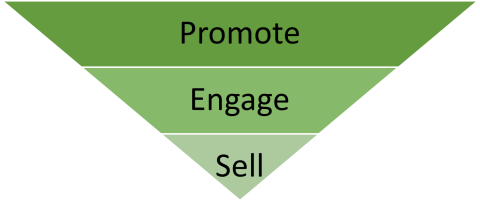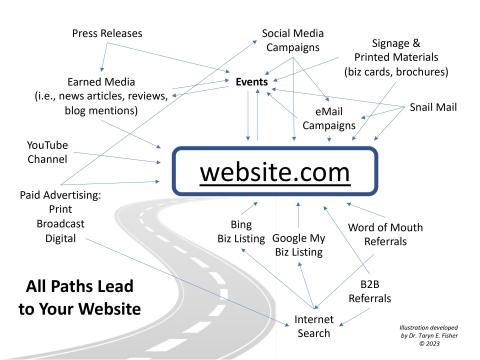All Paths Lead to Your Website
Whether your business is “bricks” or “clicks” or a combination thereof, your prospective customers will head to your website to answer an array of questions. They expect an attractive website that is well-stocked with relevant, up-to-date information, and is both easy to navigate and compelling.
Since the goal of a business is revenue, our work with clients often turns to promotion and sales, and inevitably to examining the digital footprint of the business. Organizations of all sizes and shapes must pursue a well-designed website that is search-engine optimized, and they must ensure that their strategic marketing plan drives traffic to it.
Part of a strategic marketing plan addresses the business’ sales funnel, or the process customers go through as they decide to purchase a product or service. Potential customers collect information, analyze options, and consider reviews and referrals before taking the step to purchase.
Ideally, then, promotional efforts reach all corners of the business’ target market, which expands the pool of prospects. Your value proposition, effectively communicated, compels prospective customers to purchase. Customers purchase because they believe the benefits of obtaining the product or service outweigh the cost, they think that their needs and wants have been met, and they feel satisfied. It is important to remember that maintaining a relationship with returning customers costs less than acquiring first-time customers, and the best customers are loyal champions of your brand.
Illustration: The Sales Funnel

A multi-faceted promotional program must integrate both traditional and digital tools to effectively reach your target market. As marketing strategies send prospective customers to your website, the probability increases that prospective customers seeking solutions to real (or perceived) problems that your product or services provides will expeditiously encounter your website.
Businesses must also use both traditional and digital tools to retain customers. A business’ website plays a significant role in customer retention, providing past patrons future purchasing options, product updates, how-to videos, etc.
No matter whether the sales transaction is in-person or online, when prospective customers reach your website, you want them to experience a well-designed platform that 1.) conveys your value proposition effectively, and 2.) facilitates the prospect-to-patron customer conversion.
Because everyone googles everything, let’s focus for a moment on website efficacy. I’ll use two metaphoric points of view: the front office and the back office.
The front office perspective is all about user experience (UX) and user interface (UI). UX refers to the website visitor’s entire interaction; UI refers to specific elements such as screens, buttons, toggles, and visual elements. Google Analytics can help you track metrics such as bounce rate, session duration, and conversion rate to indicate UX and UI effectiveness.
The back office perspective is all about driving traffic to your website. As search engine algorithms continue to become increasingly sophisticated, figuring out how to boost website traffic is essential. Factors and signals like keywords, quality/quantity of content, and referring domains (backlinks) inform search engine algorithms. Metrics indicate performance via number of site visits, rankings, etc.
I suggest that you take our free eCourses on digital marketing. These three address topics about websites: Three Steps to Crafting an Effective Small Business, How to Write Website Content for Humans (and Robots, too!), A Practical Approach to Website Analytics, and we have two on search engine optimization.
The marketspace is a complex, integrated, interconnected ecosystem where websites reign.
Hence, developing a marketing strategy that leverages the nooks and crannies of the competitive landscape and drives traffic to your website is critically important. The illustrative graphic that I created below demonstrates marketing tactics that can leverage your website.
Illustration: Marketspace Ecosystem

Consider how stakeholders (customers, suppliers, employees, financing entities, investors, and business partners) collect information as a basis for making decisions. Understanding the complexities and nuances of the marketspace ecosystem simplifies crafting a comprehensive promotional program.
Thus, as the center of your marketspace, your website must be equipped with a branding approach that successfully communicates your value proposition, enhances your website’s UX and UI, and translates well across both traditional and digital marketing platforms.
